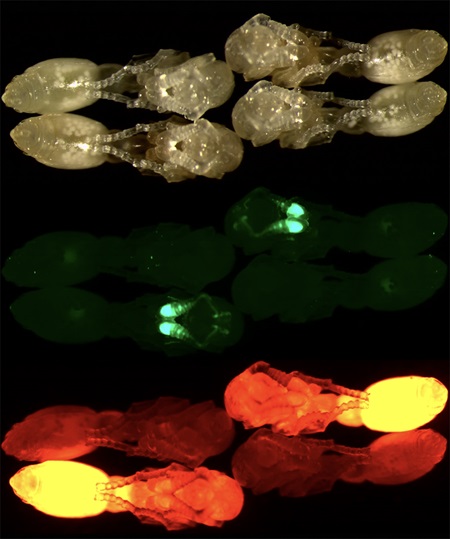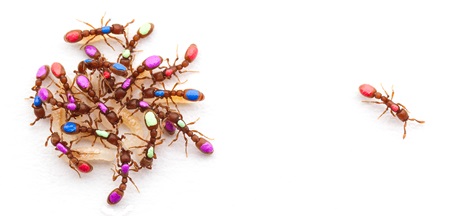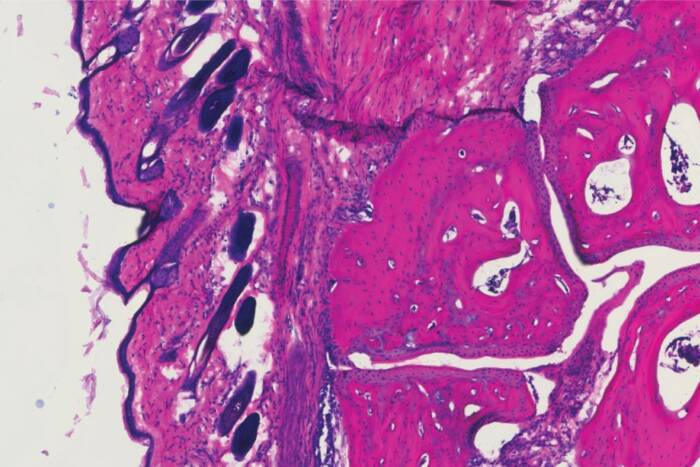What ants can teach us about the neurobiology of social behavior

Kronauer observing army ants on Mount Kenya in 2019 (Daniel Kronauer)
Daniel Kronauer has tracked army ants as they swarmed through the high-altitude cloud forests of Venezuela and photographed their bivouac nests—composed entirely of living colony members—in lowland Costa Rica. He’s collected the nectar-filled honeypot variety in the American southwest, gathered African driver ant queens—the world’s largest ants—on Mount Kenya, and plucked citronella ants from Rockefeller’s Field Research Center north of New York City.
But it’s on the Japanese island of Okinawa that Kronauer found the ants that would become his living tool for groundbreaking insights into the neuroscience of social behavior. The first colony he collected of these clonal raider ants—a blind, queenless species that reproduces asexually—would become colony C1, the Ur society of Kronauer’s Laboratory of Social Evolution and Behavior, which he founded in 2011 at The Rockefeller University.
A hundred generations of clonal raider ants later, Kronauer has turned these curious animals into a model system for studying the evolution of complex social behavior. Using innovative functional genetic and experimental neurogenetic tools, he’s revealed essential links between genes, biochemical signals, neural circuits, and social behavior.
To Kronauer, individual ants in a colony are analogous to cells in a body or neurons in a brain. “This makes them uniquely suited for investigating interesting and interconnected problems that cannot be studied in the same way in more conventional model systems,” he says.
And because humans and ants share ancient mechanisms, that model system may in turn reveal much about the bonds between human biochemistry and social behavior.
The allure of fieldwork
Kronauer grew up in Heidelberg, Germany, a medieval town about halfway between Frankfurt and Stuttgart, where his explorations of nature sparked his interest in insects. “I was always fascinated by animals that are very different from us, like ants,” he says. “Plus I really liked spending time outdoors in remote locations. In the beginning, that was a big reason I wanted to become a scientist.”
He first studied tropical ecology at the University of Würzburg but soon came to feel despair about the seemingly unstoppable human destruction of natural environments. He shifted to the university’s behavioral physiology and sociobiology department, inspired by the pioneering research of one of its luminaries, Bert Hölldobler, whose work on social behavior in ants included collaborating with Harvard’s E.O. Wilson—and winning a Pulitzer Prize for their book The Ants.
“A junior group in that department, led by Jürgen Gadau, was among the first to study population genetics and molecular phylogenetics in ants, which was really attractive to me,” he remembers.
His first fieldwork took place in a remote Arizona border town where he studied honeypot ants, so-called for the nectar-filled, amber-hued abdomens of select ants in the colony known as “repletes.” Living storage containers, repletes dispense the nectar drop by drop into the mouths of their sisters during lean times, keeping the colony alive.

A honeypot ant sips ant “milk” from the silken cocoon of a pupa. The secretion has been dyed blue to reveal its path through her digestive tract. (Daniel Kronauer)
But it was their times of war that Kronauer was interested in. Competing honeypot colonies stage elaborate, highly ritualized battles in which few ants die—an unusual outcome, since ant combat usually results in mass carnage. After the fight, the perceived winning colony raids the losers for their pupae, which are taken back to the nest. It had long been supposed that the victors ate the unfortunate offspring, but his genetic analysis showed that the young were instead reared as workers and eventually forced to labor for the collective.
“I was basically doing paternity tests,” he laughs. “I could tell which workers were the daughters of the resident queen and which were brought in from neighboring colonies.”
The finding also hinted at the origins of kidnapping behavior, which is uncommon among ants. It was another discovery, he says, that was only made possible through genetics.
Kronauer next landed at the University of Copenhagen for his Ph.D. Fieldwork in Venezuela, Costa Rica, Kenya, and other locations followed. The adventure of it all was exciting, but eventually his research goals began to pull him towards the lab.
“I wanted to do circuit-level neuroscience and behavioral genetics in very controlled environments,” he says. “The lab is a bit abstracted from the natural setting, but it also allows you to measure, control, and replicate things much more precisely.”
But he faced a significant challenge: Cut off from their nuptial flights—in which queen ants take to the air to mate with males and launch a new colony—most ant species simply refuse to reproduce in the lab.
The clones of Japan
It was towards the end of his doctoral studies that he read in a science journal about an unusual ant species studied on Okinawa by Kazuki Tsuji, of the University of the Ryukyus, that would help him get around this problem. Ooceraea biroi—aka the clonal raider ant—had simpler genetics than sexually reproductive ants, and because there were no ruling royals, every ant in the colony could lay eggs. Yet its behaviors were still highly social, as is typical of ants. It seemed like the perfect fit for his ambitions. So in early 2008, he flew across Asia to Okinawa, where he “spent two weeks flipping rocks all over the island” to capture hundreds of clonal raider ants.
Senior researchers in his field were skeptical of his ambitions, however. How would he be able to know that the data he gathered from an ersatz biome in the lab reflected true ant behavior in the wild? And the clonal raider ant wasn’t exactly representative of ants in general. How would he be able to extrapolate his findings to the broader family of ants?
Some urged him to study social organization through microbes—a popular lab-based research direction at the time.
Kronauer was unconvinced. “The clonal raider ant is immediately derived from a species that had queens, and it has a division of labor, cooperative care of the young, and an overlap of generations in a colony—every complex collective behavior is represented,” he says. “I thought I could develop them into a new model system.”
In the past decade-plus at Rockefeller, Kronauer has done just that. As a result, he’s advanced his field, innovating state-of-the-art behavioral and neurogenetic techniques for dissecting the intricacies of social behavior in clonal aider ants. These methods—including the automated behavioral tracking of individual ants in hundreds of colonies at once and the development of the world’s first transgenic ants—have elucidated how biochemical signaling helps regulate complex social behaviors that emerge from a dynamic interplay between the individual and the collective.

Two unmodified clonal raider ant pupae (top) and two transgenic pupae with fluorescent indicators (middle and bottom) (Daniel Kronauer)
Complex chemical conversations
Ants communicate with each other via biochemicals called pheromones, which are received via odorant receptors expressed on the ants’ antennae. That this back-and-forth is essential to colony function is underscored by the dominance of the olfactory processing center in an ant’s brain, which has 10 times as many subdivisions than are found in that of a fruit fly.
For that reason, many of Kronauer’s discoveries reveal how ants use this signaling system in group dynamics. His lab has shown, for instance, that the loss of pheromone sensing results in socially isolated ants. It’s identified an alert system in the brain that lights up in response to alarm pheromones, triggering a nest evacuation that includes an all-hands-on-deck rescue of the larvae—a discovery made possible by the transgenic ants whose olfactory cells fluoresce green when activated, helping them to pinpoint the alarm region in the brain. Pheromones are also the likely influence behind seemingly collective decision-making in ant colonies, whose members, they’ve found, process information similarly to the way neural networks collaborate in a brain.
Kronauer’s lab also identified a substance that inextricably links every member of a colony together: a fluid secreted by pupae that must be removed—and consumed—by the adults and larvae so the pupae don’t drown in it or die from this contaminated “milk,” which can “turn” due to the presence of fungus, just as the milk in our fridges can curdle thanks to bacteria. Consuming the nutrient-rich fluid also nourishes the entire colony; it’s packed with proteins, amino acids, sugars, and vitamins.
These findings—and more—have swayed Kronauer’s early skeptics. “All these years later, the feedback I’m getting is very positive,” he says.
Ancient bonds
But Kronauer sees even bigger prospects in his colonies.
While humans and ants may be far apart on the biological tree, conserved mechanisms that predate the evolution of either species operate in both. “Ants and humans share many neuromodulators, so we know these evolved a very long time ago,” he notes. “And it turns out that a lot of the neuromodulators that affect social behavior in humans also affect social behavior in ants.”
Our shared social-brain biochemistry includes the neurotransmitters dopamine, serotonin, and oxytocin, aka the “love hormone.”
“Oxytocin—called inotocin in ants—does superficially similar things in humans and ants in that it modulates the interactions between adults and young, but the oxytocin circuit in mammals is very complex and involves thousands of neurons, which makes it challenging to study,” he says. “In clonal raider ants, only two neurons are involved. So if you want to understand what other neural circuitry the oxytocin circuit interacts with or what downstream effects it has on neural signaling, you could look at the mechanisms in the ants, because they’re so simple.”
Insulin is another shared powerful influence. This peptide regulates nutrition-related behavior in many organisms, but Kronauer’s team found that in ants it’s also a prime mechanism for social roles and responsibilities. Insulin levels drop when adult ants are feeding larvae and rise when they’re off duty. “Hungry larvae affect the adults’ levels of insulin signaling, which is a very elegant way to make an organism sensitive to its social environment,” he says.
It’s also reminiscent of a mother ignoring her own hunger in order to feed her children first—one of the many youth-tending practices shared by ants and mammals. More will soon be brought to light, Kronauer says, including additional neuropeptides that modulate other parental behaviors.
On his research agenda for the future is experimentally interfering with the circuit-level neural activity occurring during behavioral interactions. He has a half-million ants at his disposal, including the founding clonal raider colony, C1, which continues to thrive.

Hand-painted, multicolored dots allow researchers to track individual clonal raider ants. (Daniel Kronauer)
“We might be able to reverse engineer the ants’ collective behaviors, or even create new ones that they don’t naturally have,” Kronauer says. “To me this was always kind of the Holy Grail, and it’s taken a long time to get here. So I’m really excited about the future.”
“Plus,” he adds, “I’m just really into ants.”



